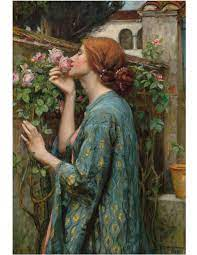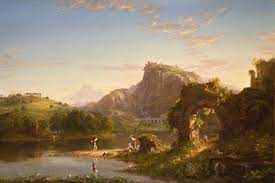Romanticism
I chose the pre-raphaelite and the Hudson River school to discuss. I personally like the pre-raphaelite paintings. The connection between nature and femininity is something I love. It brings out my inner romantic, and I like that about the style.
John William Waterhouse, The Soul of the Rose, 1908
I have a sticker of this painting, and I found his painting is both quite alluring and calming to look at, but it is painted from a painful yet romantic poem, the "Maud" written by Alfred Lord Tennyson.
This woman is based on a woman from a poem, that's about two tragic lovers who die at the end of the tale. This painting was an impressionist piece of one of the most famous lines of the poem, "come into the garden, Maud ''.
Waterhouse is an English painter who paints in the Pre-Raphaelite Brotherhood’s style. He's known for painting love-sick women in nature settings. The women he paints are powerful and enchanting, yet stuck in a cage because they are women in a man's world.
The composition of placing the wall of roses and the buildings behind her represents her entrapment both metaphorically and physically, as she cannot be with her love. In The Soul of the Rose, the woman is surrounded by a wall on the left, and to the right are buildings to form a sort of cadge framing around the subject. The painting itself is relatable; you can look at her smelling at the flowers and dissociate from your reality and smell the flowers with her.
Her face looks so inviting and sweet, like in many other Romanticism paintings. the artist applies the pose of femininity and all the grace and beauty that comes with being a woman into a wonderfully composed painting.
He also had a fascination with nature and its natural beauty and how it intertwines with feminine natural beauty. There is also a great sensual feeling to how she rests her hand on the wall while she delicately grasps the rose of which she smells, it's as if she was thinking about a familiar touch. The female character is melancholy without her true love, and you can see the longingness for her lost love in her pursed lips and closing eyes.
The Soul of the Rose is a prime example of the Romanticism movement. The painting was pulled from literature like a majority of Romanticism paintings. The woman in the painting also looks like she’s connected to nature and aware of her glooming feelings she holds.
I have a strong connection with this painting and The End of the Song by the same artist because I grew up with these paintings on my living room walls. When I was looking at pre-raphaelite brotherhood paintings, I almost squealed when I saw this painting. I always thought the woman in this painting was the most enchanting woman I've ever seen, and she looks so powerful and tender as she knights this young man.
Leighton painted most of his paintings in medieval settings and usually depicts a red-haired woman and young man. His paintings are very romanticized with a young, beautiful woman and a strong man, most likely in a tragic love scenario. In The Accolade, the romanticized couple is supposedly Guinevere and Sir Lancelot.
In the painting's foreground, you can see an elegant red-haired queen, kneeling before she is a young, handsome, newly knighted man. How the queen's hand is pointing feels like her sword is more of an extension of her arm. It makes it just that more of an intimate moment rather than a queen knighting a random soldier. The two are in love. In the woman's face, you can see the sadness in the droop in her eyes. Although you cannot see the man's face, I picture him to be sad but submissive to his country. In the mid-ground, you see the supportive populace witnessing the knighting of this man.
I can't help but have my eyes drawn to the light source coming from the top left. The way the light changes the stranded on the two major figures' hair is mesmerizing and pleasing to view. It's such a beautiful, happy, somber painting.
This painting is done in the style of pre-raphaelite brotherhood. The style comes through with an insane amount of interior details, and Leighton's signature on the stone on the bottom left. It also has the same sort of pastel-ish feel as The Soul of the Rose .
Both paintings are shrouded in a tragic romance that makes one not be able to help but feel sorrow for poor lovers.
Thomas Moran, Falls at Toltec gorge, 1913
Thomas Cole was one of the dominant members of the Hudson River school. His particular interest wasn't in creating factual places, he wanted ideal landscapes. Hence why this landscape painting is based on a poem.
Charles M. Parker commissioned Cole to paint L’Allegro and Il Penseroso. The two poems have been paired together because they depict contrasting days. L’Allegro is a warm sunny day filled with joy. While Il Penseroso is a dismal day. I've read both poems, and Cole's translation of them into art brings the poems to life.
Cole's creativity in his landscapes feels as if you've been transported into a mystical realm. In L’Allegro the speaker is imagining what his perfect spring day will look like, how it'll start in the country, and a sort of urban landscape.
In the painting, you can see ruins being taken over by nature. I think he and Waterhouse have their love for nature in common, although they were involved in different art movements. With all the nature that takes back the land, it represents the eventual downfall of the society you see in the foreground. They will soon look like the other ruins in the background, taken over by nature. He paints that no matter how many civilizations humanity makes, mother nature will always take back what's hers.
In the ruin's archway on the right of the painting, you see a man trying to manage the flora growing on the structure. Although he is fighting back, the inevitable is that it'll all be consumed over the course of years. Their society's structure is crumbling, yet it's such a beautiful day, so how could you not enjoy it?
The cool sky contrasts so well with the earthy tones below the horizon line. The composition seems to be a circle flowing from the viewer's eyes, from fallen structure to structure, and then finally to the person on the banks.
The Hudson River school usually depicted landscapes from reality, but I find the imaginative ones to be much more enchanting.
“The Soul of the
Rose.” The Soul of the Rose by John William Waterhouse,
www.john-william-waterhouse.com/soul-of-the-rose/.
“The Soul of the
Rose.” Artble, 19 July 2017, www.artble.com/artists/john_william_waterhouse/paintings/the_soul_of_the_rose.
“My Sweet Rose (Soul
of Rose) by John William Waterhouse: History, Analysis & Facts.” Arthive,
arthive.com/johnwaterhouse/works/255219~My_sweet_rose_Soul_of_rose
“The Accolade.” The Accolade by Blair-Leighton, https://www.aaronartprints.org/blairleighton-theaccolade.php.
says:, Lady Emily Rose, et al. “Cultured Wednesday: Edmund Leighton's Accolade.” Denney Home Place, 2 Apr. 2019, https://denneyhomeplace.com/2019/04/03/cultured-wednesday-edmund-leightons-accolade/.
L'Allegro, 1 Nov. 2009, https://www.youtube.com/watch?v=FR7dwoKCplo. Accessed 24 Mar. 2022.
“Thomas Moran.” Artvee, https://artvee.com/artist/thomas-moran/page/5/.



Comments
Post a Comment